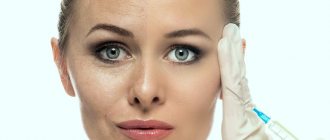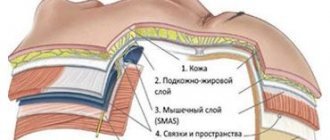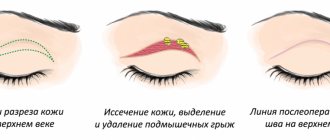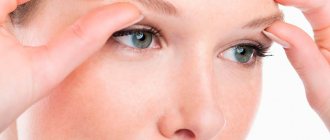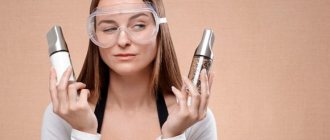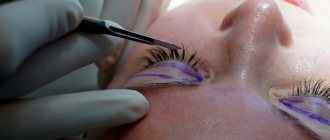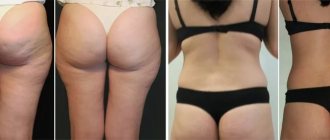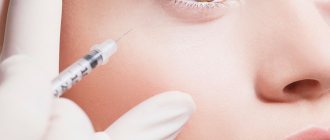When the rejuvenating eyelid surgery is left behind, the postoperative period begins. This is the time of wound healing, when the skin of the eyelids, eye muscles and other tissues are restored after damage.
Since blepharoplasty is one of the simplest operations, you can be at home within 2 hours after it.
The key to successful rehabilitation after surgical intervention will be the strict and strict implementation of all doctor’s instructions, as well as communication with him in cases of unforeseen changes.
INTRODUCTION
Eyes are not only an organ of vision, but also a key component of our image, because in them you can read a person’s mood, his character, and attitude towards others.
At the same time, the skin of the eyelids is one of the most sensitive and defenseless areas of the face. It is in the periorbital area that the first signs of skin aging often appear; it, like nothing else, can reveal our age or even add a few extra years. This is why eyelid surgery is becoming increasingly popular. However, sometimes instead of the desired aesthetic result, it can cause a number of troubles. Blepharoplasty is one of the most frequently performed and popular operations*. This is due to its short duration, low trauma, accessibility, and most importantly, good effect: as a result of this small intervention, the so-called rejuvenation of the look occurs - correction of age-related changes in the eyelid area gives the face a fresh and youthful appearance.
For a professional surgeon, eyelid correction is not particularly difficult, but he often encounters adverse events during and after surgery.
SURGERY AND/OR COSMETOLOGY
Many patients come straight to a plastic surgeon without first consulting a cosmetologist. We often hear the following opinion: “I won’t do any procedures; when it’s necessary, I’ll go and cut it off.” Unfortunately, it is not always possible to convince such patients. “Cutting off cannot restore the quality of the skin!” — by where the surgeon places the comma, one can judge his professionalism and approach to the patient. The patient’s desire to undergo surgery on unprepared and unkempt skin is the result of a deep misconception that can cause a serious mistake by the surgeon. In this case, the operation carries multiple risks, reducing the chances of quick and high-quality rehabilitation.
Since the patient planning blepharoplasty suffers from age-related changes in this area, most often we observe that he has excess stretched skin, it is dry, flabby, with impaired elasticity and tone. Poor skin quality is always accompanied by capillaropathies: deficiency of arterial blood flow, fragility of blood vessels, disorders of lymphatic and venous outflow. This leads to a number of inconveniences that interfere with the surgeon during the operation. Sometimes the doctor is not able to make a perfectly even incision, which subsequently determines the shape and quality of the scar. Thin, flabby skin literally reaches for a scalpel and the surgeon has to introduce additional volume for hydropreparation - infiltration with a special solution based on an anesthetic and vasoconstrictor (Fig. 1)
.
RICE. 1.
Hydropreparation
The introduction of an additional volume of fluid to tighten the tissue, in turn, leads to increased postoperative swelling and prolongation of rehabilitation time. Poor quality of blood vessels in the surgical area increases the risk of bleeding and the likelihood of severe hematomas (Fig. 2)
, and also contributes to poor tissue consolidation. All this makes the scarring process unpredictable and often leads to an imperfect result, for which the patient tends to blame the surgeon.
RICE. 2.
Postoperative hematomas
Hematomas and edema are the most common accompaniments of blepharoplasty. Surgeons treat these “companions” of intervention differently. Sometimes the patient only hears: “It will go away on its own” and receives laconic instructions on the use of pharmaceutical venotonics.
Fortunately, we can observe a different picture: when patients are prescribed special care products and drainage hardware procedures.
In our practice, we combine external therapy and injection methods to combat swelling and hematomas. In addition, preparing the skin before surgery helps reduce the severity of these manifestations.
Eye care
First of all, let me remind you of some restrictions necessary to avoid complications:
- Refrain from visiting swimming pools, saunas and baths.
- Avoid tanning salons and limit your exposure to the sun. At first, it is best to go outside wearing sunglasses.
- Limit your time working at the computer, contact with the phone and TV. The restriction also applies to books. Don't strain your eyes.
- Limit physical activity.
- Do not use contact lenses.
- Do not use decorative cosmetics. A break from it will benefit not only the disturbed skin around the eyes, but the entire face as a whole.
- Control your diet. Avoid alcohol. Reduce your intake of salty and spicy foods.
- Do not use ointments, creams, or drops without your surgeon's approval.
And, of course, take proper care of your eyelids. Skin care in this area provides three important functions:
- protection against microbes entering the vulnerable area
- removal of edema
- stimulation of the healing process.
Eye care begins with special bandages and plasters applied to the stitches and cold compresses. Compresses help relieve swelling.
Some experts prescribe an eye cream based on Chinese mushroom extract. It is possible that if you were planning to have blepharoplasty, you heard about it on the Internet. Like other care products, there is a lot of information about it. I won't go into details. I will only say that I categorically do not recommend using anything without the consent of your doctor. Creams and ointments are insidious things and can negate the entire effect of the operation.
In some cases, the doctor prescribes special exercises and massage. You can do both of these yourself at home. But again, only with the approval of a specialist.
PREOPERATIVE SKIN PREPARATION
It is the cosmetologist who “puts the skin in order”, restoring its turgor and elasticity, strengthening blood vessels, normalizing blood supply, oxygenation of eyelid tissue and the functioning of the drainage unit. This greatly facilitates the surgical intervention and also makes the postoperative period more comfortable. The timing of preparation for blepharoplasty depends on the quality of the skin and the age of the patient, however, we consider the optimal time to start treatment to be 3 months before the planned operation.
Based on the physiology of the skin, we attach great importance to injections of hyaluronic acid (HA). In addition to the known dermatotropic properties, its role in the healing process is important. According to the results of a meta-analysis [4], eight of the nine included studies demonstrated better healing of burns, surgical wounds, and chronic ulcers when using HA-based drugs compared with traditional treatment methods or placebo. In addition, to date, sufficient data have been accumulated on fetal regeneration and healing without scars in patients operated on in utero. This phenomenon is associated with a high concentration of GC in embryonic tissues, a significantly higher number of GC receptors in fetal fibroblasts, as well as a very low content of proinflammatory cytokines, such as interleukin-1 and tumor necrosis factor alpha [1]. Thus, a high concentration of HA promotes faster tissue healing as well as scar-free healing.
For ten years, we have been using HYALREPAIR®-02 Bioreparant (Lab. THOSCANE, Russia) with great success to rejuvenate and improve skin quality. In particular, we have accumulated extensive positive experience in conducting bioreparation courses with HYALREPAIR® Bioreparant before surgery on the skin of the eyelids.
The drug is administered using the “micropapule” technique using 32G mesotherapy atraumatic needles. A course of 4 procedures with an interval of 3 weeks between sessions provides compaction of the skin flap, increased turgor and elasticity, as well as treatment of capillaropathy (vascular fragility, impaired lymphatic and venous outflow), which helps reduce the severity of edema and hematomas in the postoperative period. The changes achieved as a result of the course contribute to better tissue consolidation and faster healing.
POSTOPERATIVE SKIN REHABILITATION
Bioreparation allowed us to achieve significant results not only before surgery, but also when used in the postoperative period. First of all, it ensures a reduction in swelling and shorter recovery times, as well as the formation of normotrophic scars.
During the natural healing process, an increase in HA content is observed already on the first day. It binds to the fibrin network, forming a transition matrix that stimulates the activation of granulocytes, macrophages and fibroblasts. By creating a moist environment on the wound surface, the transfer of growth factors released from cells is improved, the migration of fibroblasts and the proliferation of epithelial cells are enhanced. The interaction of HA with cells is carried out through the CD44 and RHAMM receptors. Their condition significantly affects the rate of healing of skin lesions [2]. Transgenic mice with suppressed expression of RHAMM or CD44 in epidermal keratinocytes exhibit delayed wound healing [3], indicating the involvement of HA receptors in signaling pathways that support repair processes and the important role of hyaluronan in healing in general.
Based on the above, as well as from personal experience, we have selected the optimal time to begin bioreparation, scheduling it for 7–10 days after blepharoplasty. The start of bioreparation is timed to coincide with the period of reduction of edema and natural decrease in BG levels after a sharp rise due to injury. This maintains the level of hydration, ensuring an effective wound healing process, and improves the process of synthesis of new collagen for the formation of an invisible scar. At the same time, the quality of the eyelid skin improves, which allows us to achieve good results both in our assessment and in the opinion of patients.
The recommended course in the postoperative period is determined by the attending physician; usually, complete recovery requires 2–4 bioreparation procedures with HYALREPAIR® Bioreparant, performed once every 21 days.
How to treat stitches after blepharoplasty?
The placement of sutures after blepharoplasty is determined by the type of surgical approach. If the incision is made in violation of the integrity of the skin, sutures are required. If it was done from the side of the conjunctiva, they may not exist.
In the first few days, it is very important to follow the rules of hygiene in order to prevent the wound from becoming infected. Mechanical influences, friction, massage, and exposure to sunlight are excluded. Even contact with water should be prevented on the first day after surgery.
Having completed the operation, surgeons apply a special sterile plaster to the wound, which promotes the best comparison and approximation of the edges of the wound. During this period, cooling compresses can be applied to reduce swelling and bruising. After removing the patch, the wounds should be treated with an alcohol-free antiseptic solution (chlorhexidine and analogs). Also, at first, medications are prescribed to reduce swelling and quickly resolve hematomas.
The surgeon will definitely instruct you how, when and with what to treat postoperative wounds.
If the incision was made from the mucous membrane, the doctor will recommend using an anti-inflammatory eye ointment. It temporarily blurs vision, but this is not a reason to stop using it.
For painful symptoms, you should take a pain reliever.
CLINICAL CASES
EXAMPLE 1
Patient A., 59 years old, turned to a plastic surgeon to remove an overhanging fold of the skin of the upper eyelid. Blepharoplasty was performed with excision of excess skin flap. I was pleased with the result, but there was still discomfort and a pulling scar in the area of the inner corner of the eye (Fig. 3)
.
20 days after the operation, taking into account the age and condition of the skin, the patient was recommended a course of bioreparation consisting of 3 procedures. Injections were performed using the papular technique in the projection of the postoperative scar and the area 5 mm above and below. The diameter of the papules was 1 mm, the distance between the injections was 1.5 - 2 mm. The optimal needle gauge is 32G.
As a result of the injection course with HYALREPAIR® Bioreparant, the skin in the eyelid area became denser, more elastic, the scar became lighter and stopped bothering us after the first session (Fig. 4)
.
RICE. 3.
Patient A. Pulling scar of the upper eyelid.
RICE. 4.
Patient A. Scar condition before treatment (A) and after 3 injection therapy procedures (B).
EXAMPLE 2
Patient N., 40 years old, with thin skin. Blepharoplasty of the lower eyelid was performed, hernias were removed, and the internal and middle fat packets were redistributed and the nasolacrimal groove was filled.
In the postoperative period, the patient began to be bothered by heaviness and tightness in the lower eyelid; upward movement of the eyeball was accompanied by movement or retraction of the eyelid (Fig. 5, A)
. In order to improve the elasticity of the skin of the lower eyelid, 2 procedures were performed using HYALREPAIR®-02 Bioreparant with an interval of 3 weeks. Injections were carried out using the technique described above.
The patient was satisfied with the elimination of adverse events (Fig. 5, B)
.
RICE. 5.
Patient N. Condition of the eyelid skin after blepharoplasty before (A) and after 2 bioreparation procedures (B).
How long do bruises and swelling last after blepharoplasty?
Dynamics by day
1-2 days. Immediately after surgery, the eyelids swell. During the first hours, swelling increases and reaches a maximum by the end of 2 days. In some cases, hematomas spreading to the zygomatic region are possible.
3-4 days. The swelling begins to decrease. Blue bruises become yellow, brownish and greenish, fade and decrease in size.
5-7 days. The swelling subsides.
8-10 days. Small residual swelling and hematomas are possible. The patient can return to his normal lifestyle.
10-20 knocks. The face looks normal, but there is still excess fluid inside the tissues - this may manifest itself as slight asymmetry of the eyelids.
20-60 days. Complete healing and restoration of eyelid tissues after upper, lower and circular blepharoplasty: even internal residual swelling disappears completely.
This dynamics is relevant if you do not have urinary, vascular, or other pathologies that provoke swelling, and at the same time you follow all the recommendations of the plastic surgeon. In addition, the process is influenced by factors such as:
- age – the older you are, the more time your body needs to recover;
- the thickness of the subcutaneous fat - the thicker it is, the more water is retained in it and the slower the swelling goes down;
- skin thickness - the thinner it is, the more visible swelling is;
- technique and scope of the operation - the more surgical procedures, the longer and deeper the incisions for access, the more pronounced the swelling and the longer the rehabilitation.
Swelling of the upper eyelids lasts longer because there is less active blood supply in this area.
CONCLUSIONS
We successfully use the approach proposed above in our practice to improve the results of surgical intervention. By combining injection therapy and blepharoplasty, we achieve an objectively good result with no or minimal complications. According to the analysis of the results of our research, the rehabilitation period for patients was reduced by 1.5 - 2 times, the number of patients assessing the result of the intervention as “exceeding expectations” increased, and therefore we recommend introducing our experience into the practice of aesthetic medicine.

